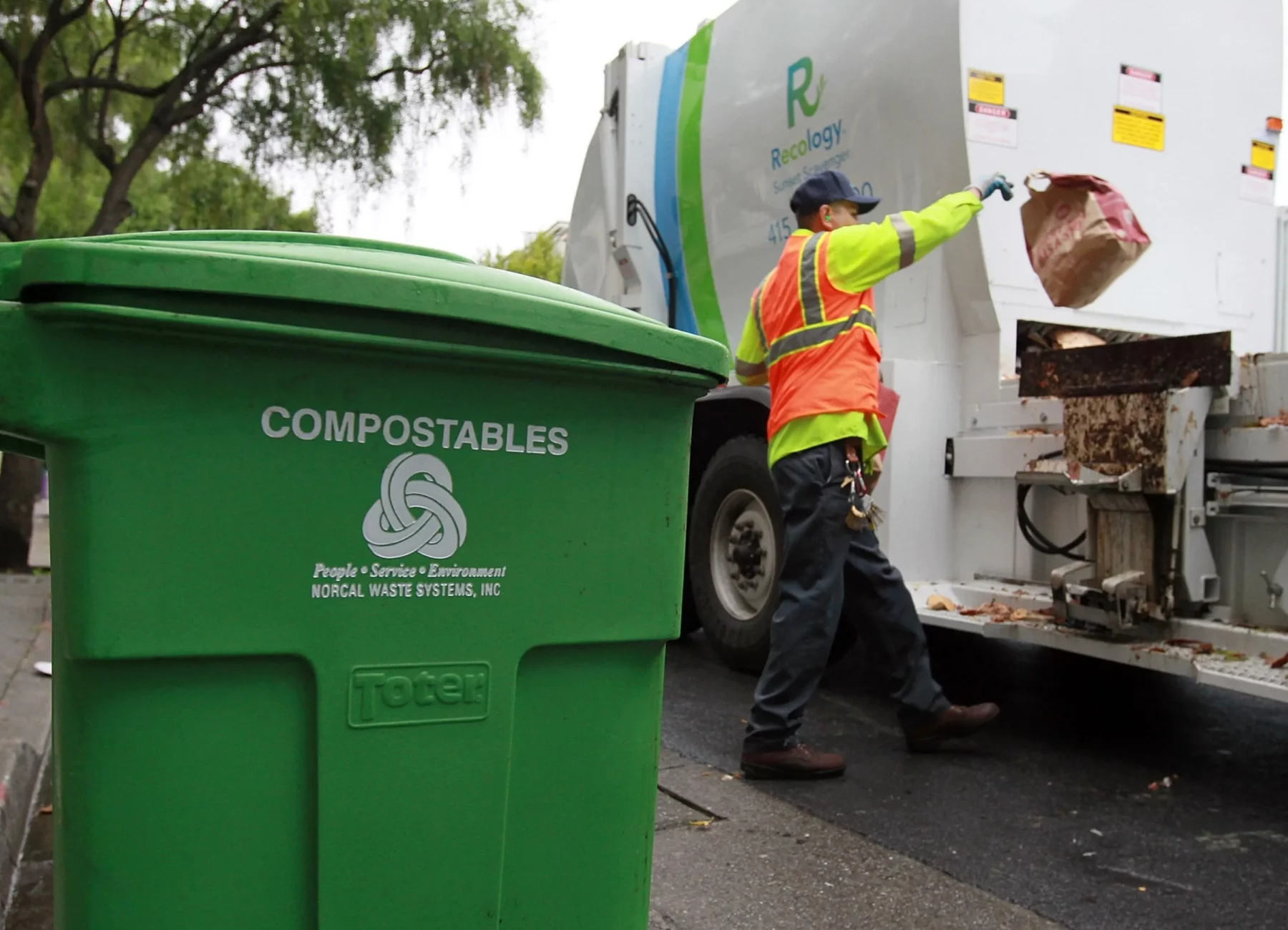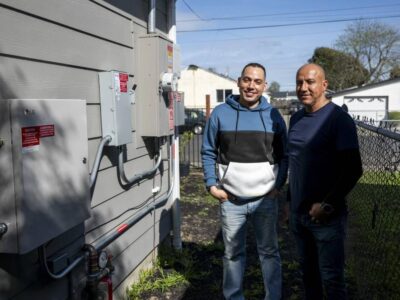(Bloomberg) —
On a microscopic level, composting refers to a biological process where bacteria, fungi and even worms break down organic material to generate a product that looks like soil but is technically a soil amendment. This nutrient-rich blend can be used to improve soil quality, making it easier to grow everything from house plants to crops.
On a practical level, compost — a product formed in darkness — is increasingly stepping into the spotlight. Earlier this year, New York City announced plans to expand its composting program citywide by late 2024, the latest example of a trend that in the US started with San Francisco’s launch of a composting program in 1996. Other cities, including Seattle, Boston and Boulder, Colorado, have also unveiled composting programs, and in 2020 Vermont went a step further, banning the disposal of food scraps in trash or landfill waste.
For municipalities, composting is often cheaper than landfilling over the long term, says Eric A. Goldstein, a lawyer who works on New York City programs at the nonprofit NRDC. “The cost of disposal is higher at landfills and incinerators because municipalities are dropping off a product that is a waste product that has no practical use,” Goldstein says.
For individuals and locales looking to cut their emissions, composting also has the benefit of helping to address climate change. “When food scraps and yard waste are buried in landfills, they decompose and generate methane, a very potent global warming gas,” Goldstein says. “Landfills are the third largest source of methane emissions in the United States. So if we are going to get a handle on the climate crisis, we’ve got to find a way of keeping organics like food scraps and yard waste out of landfills.”
Actually doing that, though, can seem daunting at first – plenty of Americans are still figuring out what goes in which recycling bin. While composting guidelines vary based on where you are and what kind of bin you have access to, here are some tips for how to compost across the US.
How to get started with composting
There are a few different ways to compost. Your city or municipality can collect your food waste if it has a program in place. You can also drop your food waste off at specific composting collection locations, or you can compost at home.
If your community has a composting program, it usually involves getting a dedicated composting bin — they’re green in San Francisco and brown in New York City — that is picked up on a set schedule, often weekly. (Here’s one tool to identify programs and pickup points near you.) In addition to compost pickup, many cities also have drop-off services that allow people to leave their compost at dedicated bins on the street, or in locales like farmers markets and community gardens.
If you don’t have access to community collection or drop-off locations, that doesn’t mean composting is out of reach: There are a growing number of private residential composting services. In some parts of New England, for example, Bootstrap Compost will drop off a 5-gallon bucket for compostables and pick it up weekly for $11 or biweekly for $15. North Carolina-based company Compost Now offers a similar service in parts of the Southeastern US and in Ohio.
You can also craft a DIY composting solution. If you have a yard or other outdoor space, that means getting a dedicated bin to put food scraps in and figuring out the right ratio of “greens” (like food scraps) and “browns” (like leaves and cardboard) to ensure your materials break down relatively quickly and without stinking. Done right, it takes three to six months for everything to break down and the pile should have an earthy smell.
A number of detailed composting guides are available online, with insights on everything from choosing a bin to rodent-proofing to checking compost quality. (Try this one from New York City’s Department of Sanitation.) Even apartment-dwellers can take a stab at composting indoors by using worms.
What you can compost
If your compost is going to a commercial facility — like those used by municipal compost systems — you can drop in almost anything that’s edible or comes from a plant. That includes yard waste (leaves, grass clippings, etc.) and foodstuffs (banana peels, orange rinds, slightly spoiled lettuce, etc.) It also typically includes animal products — whether it’s eggshells, old cheese or the roasted chicken leftovers that went bad at the back of the fridge (bones, too).
Because paper comes from trees, it too can be composted in a commercial facility as long as there isn’t any plastic or waxy coating. Greasy pizza boxes, food-stained paper plates or napkins, and coffee filters and grounds can all go into your compost bin.
The rules are a bit different if you’re composting at home or in a community composting project. Yard clippings, vegetable waste and things like pasta in tomato sauce can still go in, but meat and other animal products can’t. That’s because smaller-scale composting doesn’t get warm enough to kill the potential pathogens from animal products, or have the ability to handle things like biodegradable plastics (unless they’re specifically labeled okay for home composting). Coffee grounds and filters are still fine, as are relatively clean pizza boxes. (If you’re worm composting, shred the boxes first.)
What you can’t compost
Plastics can’t be composted unless they’re specifically marked otherwise. Paper products that are in good condition (i.e. not stained with food) should be recycled, not composted, if your community offers paper recycling. Metals (like cans and aluminum foil) should also go in recycling.
Milk cartons, which are made from coated paper, should not be composted. Tea bags used to be reliably compostable, but because they are now often made with plastics, these too should be left out (though the tea itself is compostable).
Natural-fiber clothing (like wool, cotton, and silk) could in theory be composted. But because they’re often blended with synthetic fibers that are not compostable, including polyester, acrylic and elastane, you should avoid composting fabric.
Like some clothes, pet waste can also be composted in theory. But adding it to the mix carries the risk of spreading pathogens, so to be on the safe side you shouldn’t. The good news is there are organizations piloting projects that compost dog poop with additional safety measures.
How to store your food scraps
One of the trickier parts of the composting process is figuring out how and where to store excess food scraps before they’re dropped off or added to an outdoor compost bin.
If you have a worm bin, the easiest thing to do is keep the bin in the kitchen and put scraps directly inside. If you’re doing yard composting, you can get a small kitchen container and take it out daily. For those who have to go longer between pickups or drop-offs, keeping a modest-sized compost bin in the freezer can cut down on odors and flies. For those with bigger needs, a 5-gallon bucket (like the kind paint comes in) with a tight-fitting lid can also work. If your food scraps are going to a commercial facility, you can line the containers with compostable bags to make cleaning easier.
Read More: The Quest to Make Composting as Simple as Trash Collection
While composting is a great way to curtail your carbon footprint, there is one even more effective way of keeping food waste out of landfills: Don’t produce it in the first place. Americans currently throw away roughly a third of the food they bring home from the supermarket.
“The US Environmental Protection Agency adopted a solid waste hierarchy of how to sustainably handle waste,” Goldstein says. “And of course at the very top by far and away the best thing you could do is to generate less of it in the first place.”
To contact the author of this story:
Kendra Pierre-Louis in New York at kpierrelouis@bloomberg.net
© 2023 Bloomberg L.P.





